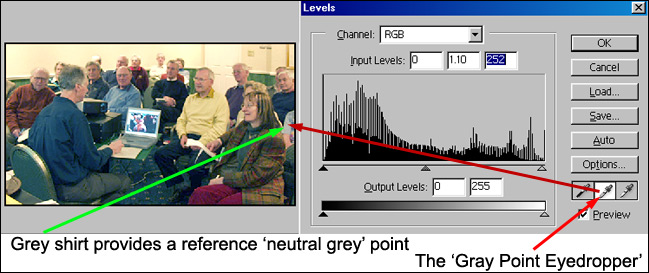'Levels'
Dealing with a 'Colour Cast'
Clive R. Haynes FRPS
These notes have
a specific reference to dealing with a colour cast within a scene where
the shift in colour balance is caused by the lighting being 'out of
balance' with the film type or camera setting (DI camera 'white balance').
A typical example would be a scene shot on daylight balanced film under
artificial light (tungsten, fluorescent strip etc).
Setting
points with the Eyedroppers
- A Reminder
The three eyedropper icons in the 'Levels' dialogue box allow us to set
the black point and white point whilst the Grey
Point eyedropper is for setting a neutral tone of grey -
and it's this facility we'll be using to deal with 'Colour Cast'.
The scene below is an example of the sort of problem.
This is a picture of yours truly giving a talk to a group of people under ordinary tungsten room light. As you can se there is a severe warm colour cast.

This is where the 'Grey Point Eyedropper' is of great use.
The preferred route
is via an 'Adjustment Layer' - as the 'Mask' facility within the Adjustment
layer allows us to selectively erase the corrected areas should we wish.
If your uncertain about 'Adjustment Layers' use the link at the base of
this page.
Creating a 'Levels' Adjustment Layer.
At the base of the Layers palette,
click on the half black / half white circle icon ![]()
From the 'drop-down' list that appears,
choose 'Levels'.
In the 'Levels' dialogue box, click on the 'Set Gray Point' Eyedropper and look carefully at the image. Find an area of what should be neutral grey, no matter how small, it could be a pair of grey trousers, a grey shirt or a grey piece of machinery - whatever. Click on this and hey presto - the image tonality instantly shifts to make the grey tone a neutral grey, shifting the colour bias of the whole image - magic!
If alternative neutral greys are in the scene, try each until the correct tonality is achieved.
Note: The
area of image that should be neutral grey must have been
included in the original scene - it has to have received the same lighting
(or mix of lighting) as the scene. It's no good generating a neutral grey
afterwards!
Let's see what happens when we tackle the scene above in this way. In
our example, I was fortunate to have more than one reference grey point.

Having fixed the problem some fine tuning may be necessary.
Photoshop features several controls that can help in manually shifting the colour bias of the image either generally or targeted to a specific area. The most usual routes are accessible via the Image > Adjust menu, or more preferably via an Adjustment Layer and are:
Color Balance
Hue & Saturation (adjust the Hue slider)
Replace Color
Selective Color
Channel Mixer
Variations (not via an Adjustment Layer)
Anticipate the
Problem - Plan Ahead
If you are aware of the potential problem of colour cast before you
shoot, then introduce a Kodak Grey Card into the scene - it can be cropped
off later or 'cloned out' with the Clone Stamp tool. Be careful to position
the Grey Card under the same lighting conditions as for the subject/scene
for it to be effective.
Mixed lighting?
Either place the Grey Card in a position to receive the mixed light
or take two pictures. Later, correct each separately and combine the
result.
A Reminder: After
loading/scanning the image into Photoshop, make an Adjustment Layer
and choose 'Levels' then with the 'Set Grey Point Eyedropper' activated,
click on the Grey Card in the scene and the correction is instantaneous!
Same Problem - Same lighting - Different Scenes?
If you have several scenes all with the same lighting/colour cast, shoot
one scene with the Grey card.
After correcting in Photoshop, click & drag the corrected 'Levels' Adjustment
Layer from the first image window onto the next image. The Adjustment
Layer will appear in the new image Layers Palette with the adjustment
already made.
If you have used the mask facility to paint out/mask areas on the Adjustment
Layer of the first image, you'll need to fill the 'copy' Adjustment
layer on the new image with white to delete these areas.
Alternatively,
the settings for the corrected scene could be 'saved'.
Do this by clicking on the 'Save' button in the 'Levels' dialogue box.
Give the correction a name and save it in a folder.
Next time,
when the same correction is required, click on the 'Load' button in
the 'Levels' dialogue box, go to the necessary folder, find the title
you require, click and it will be done. Simple.
To discover more about transferring Adjustment Layers from one image to another - click on the link below.